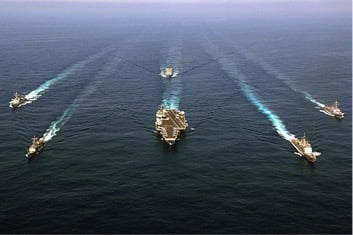By Ed Timperlake
The famous Navy saying “we are ready now” also means Navy R&D focus is to always be ever vigilant in building for the future. The future is now but it is anchoring as well a way ahead.
In fact, for 2025 and beyond, the US Navy is the gold standard for the world for R&D research in understanding the technological imperative of an action/reaction cycle of weapons development against a reactive enemy.
We have moved from an organic Carrier Battle Group to a kill web “no platform fights alone” approach which expands the impact of the carrier on the battlespace and in turn the carrier can leverage joint capabilities not present on the carrier itself.
There is also the great historical demonstrated strength in the combat history of the Navy with their famous “Ready on Arrival” combat ethos.
With the current endless wars, a lot of attention has been focused on the combat effectiveness of the large deck carrier.
When a Carrier Strike Group, previously called a Carrier Battle Group sorties into harm’s way it is a global power projection combat capability.
In 1966 the US Navy made a short movie about what was then called an “Attack Carrier.”
The movie describes going to flight quarters and conducting combat air operations from an aircraft carrier off Vietnam.
The US Navy when sent in harm’s way does whatever is asked to their last full measure, combat is their profession and loyalty to the Constitution not politics is their code.
“Ready on Arrival” highlights a simple truth evident today off Afghanistan that the direct lineage of the large deck aircraft carrier is an American point of pride.
A modern carrier ready today launching into Afghanistan personifies the fundamental point of the movie that the U.S. can with unexpected events put a Carrier on Station to support friends and confront enemies.
Note that at times, as stated, the surface Navy can also undertake independent offensive operations, as the Russians in combat support for the President of Syria recently found out, after the Syrian President used chemical weapons on his opponents:
“They that go down to the sea in ships that do business in great waters.”
Psalms 107:23-31
When President Trump gave the go order to attack Shayrat Air Base Syria, where a chemical attack had been launched, two US Navy surface warships stood ready to implement the order.
In one shining moment with Tomahawks fired from USS Porter and USS Ross, the world knew a new Commander-in Chief was at the helm.
It was reported that 59 of the 60 Tomahawks hit the intended target. Our way of war was to actually warn the Russians to minimize any chance of Russian’s being hit or killed — how nice for them.
The USS Porter and USS Ross successful attack showcased the command structure of the 21st Century Navy.
No finer complement can be given to the 21st Century navy and the dynamic and extremely successful contribution’s being made by the admission of women to the US Naval Academy than seeing the Commanding Officer of USS Porter have her crew earn an historic famous Flag Hoist “Bravo Zulu” for Job Well Done.

Cmdr. Andria Slough graduated from the academy with a Bachelor of Science degree in ocean engineering. She serves as the commanding officer of the USS Porter, a Navy destroyer in the eastern Mediterranean Sea.
Performance counts from day one regardless of how one earns a commission.
The Skipper of the USS Ross, Commander Russell Caldwell, hails from Johannesburg, South Africa. Commander Russell Caldwell graduated the University of Kansas with a Bachelor of Science in Political Science and was commissioned on January 10, 1998.

The other “ready now” teams engaged in direct combat have been the special warfare community, the Navy SEALs, who also work with the Navy’s Silent Service.
I had the opportunity in December 2011 to see an advanced preview of the movie “Act of Valor,” an action thriller about US Navy SEALs, and my first impression was that it was sending a very powerful message to the enemies of America: Navy SEALs will be coming and you will be killed.
It was refreshing and rather unique to see a movie identify the real enemy; fanatical, death-loving Islamist extremists and no politically correct BS with surrogate enemies such as machines, fighting robots or space aliens.
Also appreciated was how the film depicted the military without emoting or second-guessing their chosen profession.
The almost obligatory Hollywood “Oh the inhumanity of it all!” moment did not arrive.
Some SEAL teams may have pensive introspective poets or tortured souls in their ranks but not in this movie.
The real payoff of taking the risk of using actual SEALs was the fluidity of their motion.
They moved like real warriors.
Based on my many years of experience, the real military is just as it is depicted in the film.
The physical movement, use of technology, submarine featured, and firepower and an ending that provides a sobering reminder of the human cost of fighting terrorism make this film outshine your standard action/adventure movie.
What President Putin and his IW propaganda team do not understand is that as a Carrier Strike Force goes forward the Admiral and his entire team are ever vigilant about unknown submarines.
Just because the Navy doesn’t talk much about all aspects of Anti-Submarine Warfare doesn’t mean they ignore that domain, in fact it is just the opposite.
This is the third piece in our series on the response to Putin’s escalatory rhetoric and force structure planning.


